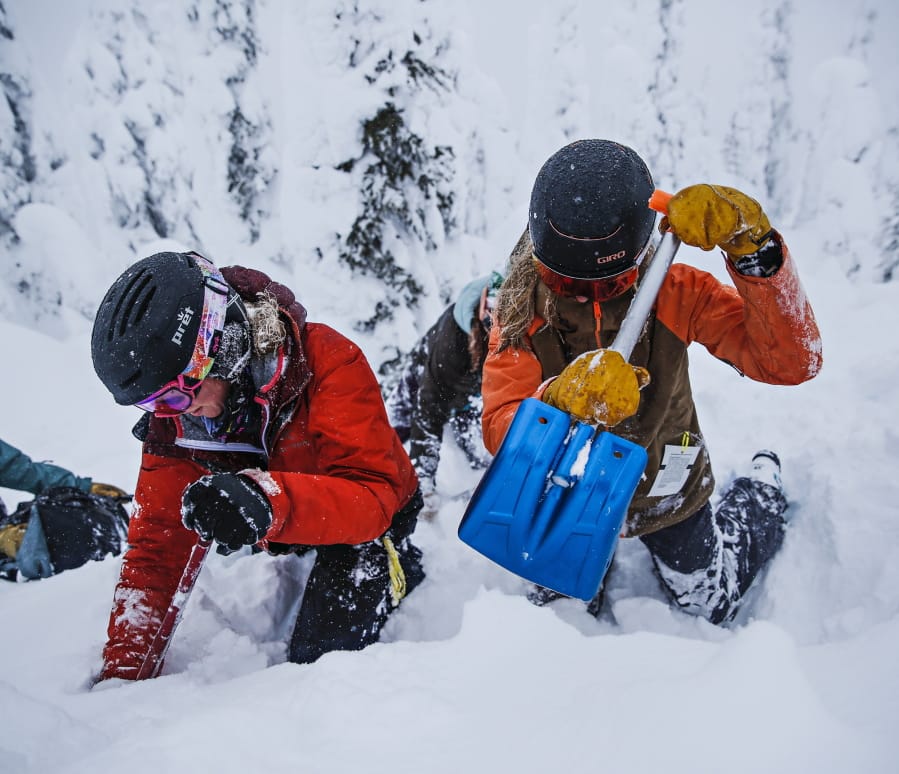KALISPELL, Mont. — As Sarah Schmidt skinned beyond the boundary line of White Pass Ski Area in Washington with her two friends, they stopped at the peak that overlooked Mount St. Helens, Mount Adams and Mount Rainier on an unusually clear January day.
There was about 10 inches of fresh powder and the avalanche forecast was “considerable” that day, a gray area on the danger scale in the forecasting world, which is usually associated with uncertainty in the snowpack.
As Schmidt and her two male ski partners took in the view, she realized they hadn’t discussed where they were skiing. They could descend into a steeper, cliff area where a nearly 800-foot vertical bowl lay beneath, or they could ski in a gentler zone where sparse trees replaced craggy cliffs.
One member of the group was interested in the more aggressive terrain, but Schmidt voiced her concerns about the sketchy avalanche conditions, and they chose the safer route through the trees.
“We hadn’t talked about a plan, and I was the one to initiate the discussion,” she told the Flathead Beacon.
Not every backcountry group effectively communicates the way Schmidt’s did, even as experts emphasize the importance of open dialogue in backcountry settings while also highlighting the gender imbalances that can exacerbate the problem. But now there are growing efforts to address those issues through education, especially women-only classes, both nationwide and in Montana.
Schmidt was traveling that day with two people 10 years older who had more backcountry experience, and she hadn’t yet taken an Avalanche Level 1 Course at that point, all of which relegated her to junior decision-maker status. But her decision to step forward may have prevented a dicey situation. Many other people without formal avalanche education don’t have the confidence to speak up, however, and if they do, their voices often aren’t heard.
“It’s one of those things where people need to talk, and that’s why these classes are empowering,” Schmidt said. “They give you a platform to speak up.”
Intimidation can play a role in backcountry skiers’ reluctance to take a course, especially women who are trying to break into a traditionally male-dominated sport. Some women who are new to the backcountry are hesitant to take avalanche classes in fear of being a lone woman in what they think might be a sea of testosterone and inflated egos at an entry-level Level 1 course.
“When I first got into backcountry skiing in my 20s, I was relying on friends and was not engaging myself,” Friends of the Flathead Avalanche Center Education Coordinator Meg Killen said. “I was intimidated to take the classes.”
Whitefish Mountain Resort and The Patrol Fund, a fundraising program for avalanche courses, started hosting the Ladies Only Level 1 Avalanche Course in 2017, partly because research in recent years suggests that women-only groups in the backcountry result in better decision-making. The popular classes consistently fill up, drawing both locals and out-of-staters like Schmidt.
“Part of why we like to provide women’s courses is the dynamic is different in decision-making,” said Jenny Cloutier, a Level 1 avalanche instructor and the former FOFAC education coordinator. “It’s actually been shown that mixed-gender groups are the most dangerous groups, and we wanted to provide a venue for women to learn and kind of have some of those barriers broken down.”
In research compiled by The Avalanche Review editor Lynne Wolfe in 2004, she interviewed four female snow professionals to compare group decision-making dynamics between women’s and mixed-gender groups. The women generally concurred that decision-making depends on the individuals in the group. However, they admitted that they exhibited riskier behavior in mixed groups and tended to ski in more conservative terrain in women’s groups. Some of those interviewed found that all-women’s groups make decisions by consensus rather than by following a leader.
Wolfe also noted in her own observations from her experience teaching women-only classes that they are “adamant that their voices are better heard in all-women’s groups and they are more willing to experiment in those groups.” Those decision-making dynamics help determine whether or not a group is caught in a heuristic trap, which occurs when people ignore obvious hazards and are misled by rules of thumb that give inaccurate representations of danger.
Whitefish psychologist and avalanche educator Sara Boilen says the loudest, fastest person in a party is often the person who makes decisions in groups. But if groups make decisions based on consensus, women or anybody prone to being quiet will have more opportunity to speak.
Women-only classes lend empowerment to students who may have previously depended on others. In a male-dominated field, women often go into the backcountry with a male partner. Cloutier has noticed that in some circumstances, that male partner is the one digging snow pits, determining the snowpack’s safety and making the decisions.
“There’s the idea that women are less likely to speak up because they don’t want to rock the boat and they want to be included or asked to go out again,” Cloutier said.
Cloutier and Killen both look forward to the all-women’s courses and agree that they are the most fun to teach. They notice a team-building component in the ladies’ course that isn’t as evident in mixed-gender groups.



